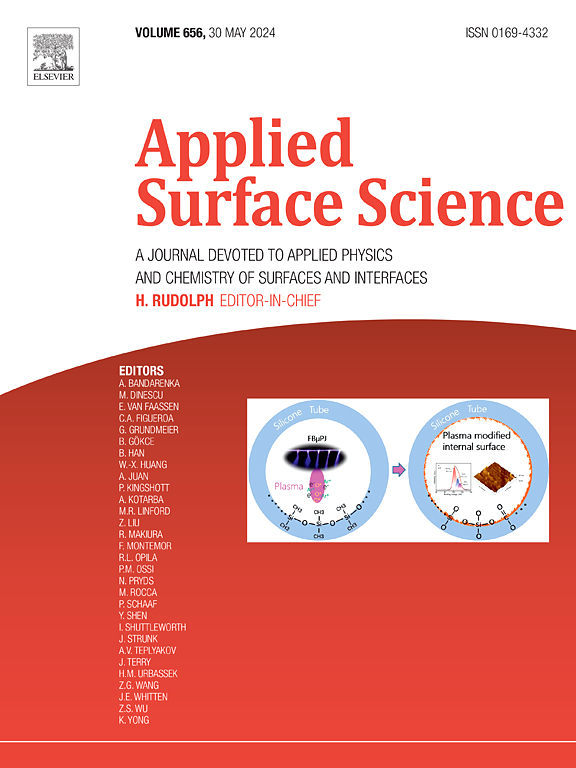温度对激光烧蚀 APPJ 刻蚀 N-BK7 光学玻璃残留物的影响
IF 6.3
2区 材料科学
Q2 CHEMISTRY, PHYSICAL
引用次数: 0
摘要
大气压等离子体射流(APPJ)加工光学材料,如熔融二氧化硅和碳化硅,能够产生具有优异精度和低表面粗糙度的自由曲面光学表面。然而,对于含有各种金属氧化物的常用光学玻璃N-BK7®,用含氟气体进行APPJ蚀刻,会形成由金属氟化物组成的表面残留物。积累的残留物在玻璃基板上形成一层,在蚀刻速率和表面粗糙度方面恶化了蚀刻过程,但可以通过脉冲激光照射烧蚀。本研究的目的是减少激光去除所需的残余层厚度,这是提高形状精度和减少工艺引起的粗糙度的先决条件。N-BK7®样品在不同表面温度下用APPJ蚀刻。然后用不同波长的准分子激光照射appj蚀刻区(λ = 193;248年;308 海里;tPulse = 20 ns)。然后用WLI和SEM分析了蚀刻和激光暴露的样品表面。结果表明,在193 nm和248 nm波长处,可以去除不同温度下蚀刻产生的残留层。在193 nm的波长下,可以完全去除的最薄层为95 nm。λ = 248 nm的最小层厚度在190 ~ 320 nm之间。在308 nm的波长范围内,既没有检测到残留层的去除,也没有检测到玻璃的损坏。本文章由计算机程序翻译,如有差异,请以英文原文为准。


Impact of the temperature on laser ablation of residues from APPJ-etched N-BK7 optical glass
Atmospheric pressure plasma jet (APPJ) machining of optical materials, e.g. fused silica and silicon carbide is capable of generating free-form optical surfaces with excellent precision and low surface roughness. However, APPJ etching of the commonly used optical glass N-BK7®, which contains various metal oxides, with fluorine-containing gases results in the formation of surface residues consisting of metal fluorides. The accumulated residues form a layer on the glass substrate that deteriorates the etching process in terms of etching rate and surface roughness but can be ablated by pulsed laser irradiation. The aim of this study is to reduce the residual layer thickness required for its laser removal as a prerequisite to increased shape accuracy and reduced process-induced roughness.
N-BK7® samples were etched with APPJ while varying the surface temperature. Subsequently the APPJ-etched area was irradiated by excimer laser at different wavelengths (λ = 193; 248; 308 nm; tPulse = 20 ns). The etched and laser-exposed sample surfaces were thereafter analyzed by WLI and SEM.
It can be shown that residual layers resulting from etching at different temperatures can be removed at wavelengths of 193 nm and 248 nm. The thinnest layer for complete removal demonstrated is 95 nm at a wavelength of 193 nm. The minimum layer thicknesses for λ = 248 nm are in the range of 190–320 nm. At a wavelength of 308 nm, neither removal of the residual layer nor damage to the glass could be detected for the selected fluence range.
求助全文
通过发布文献求助,成功后即可免费获取论文全文。
去求助
来源期刊

Applied Surface Science
工程技术-材料科学:膜
CiteScore
12.50
自引率
7.50%
发文量
3393
审稿时长
67 days
期刊介绍:
Applied Surface Science covers topics contributing to a better understanding of surfaces, interfaces, nanostructures and their applications. The journal is concerned with scientific research on the atomic and molecular level of material properties determined with specific surface analytical techniques and/or computational methods, as well as the processing of such structures.
 求助内容:
求助内容: 应助结果提醒方式:
应助结果提醒方式:


